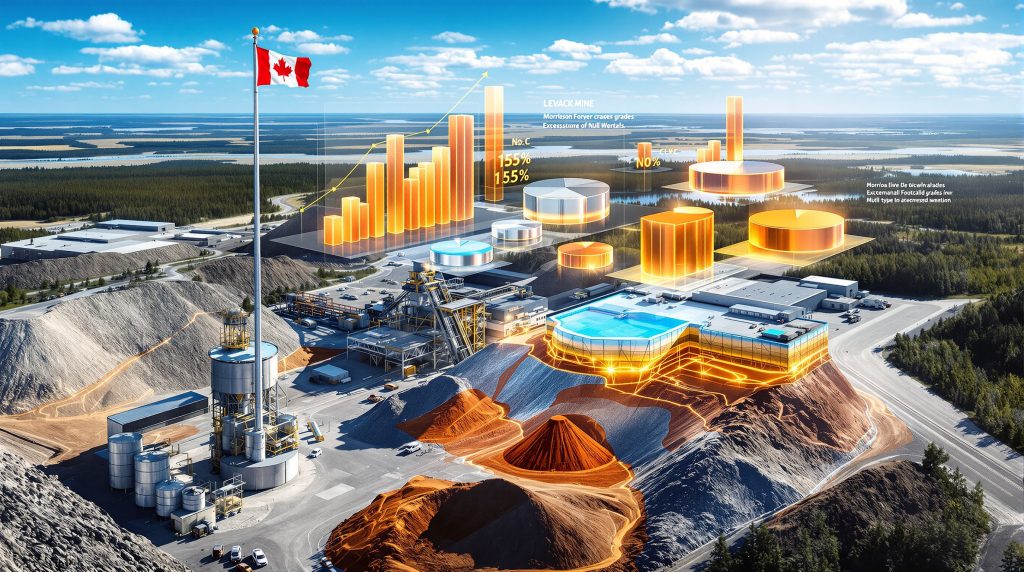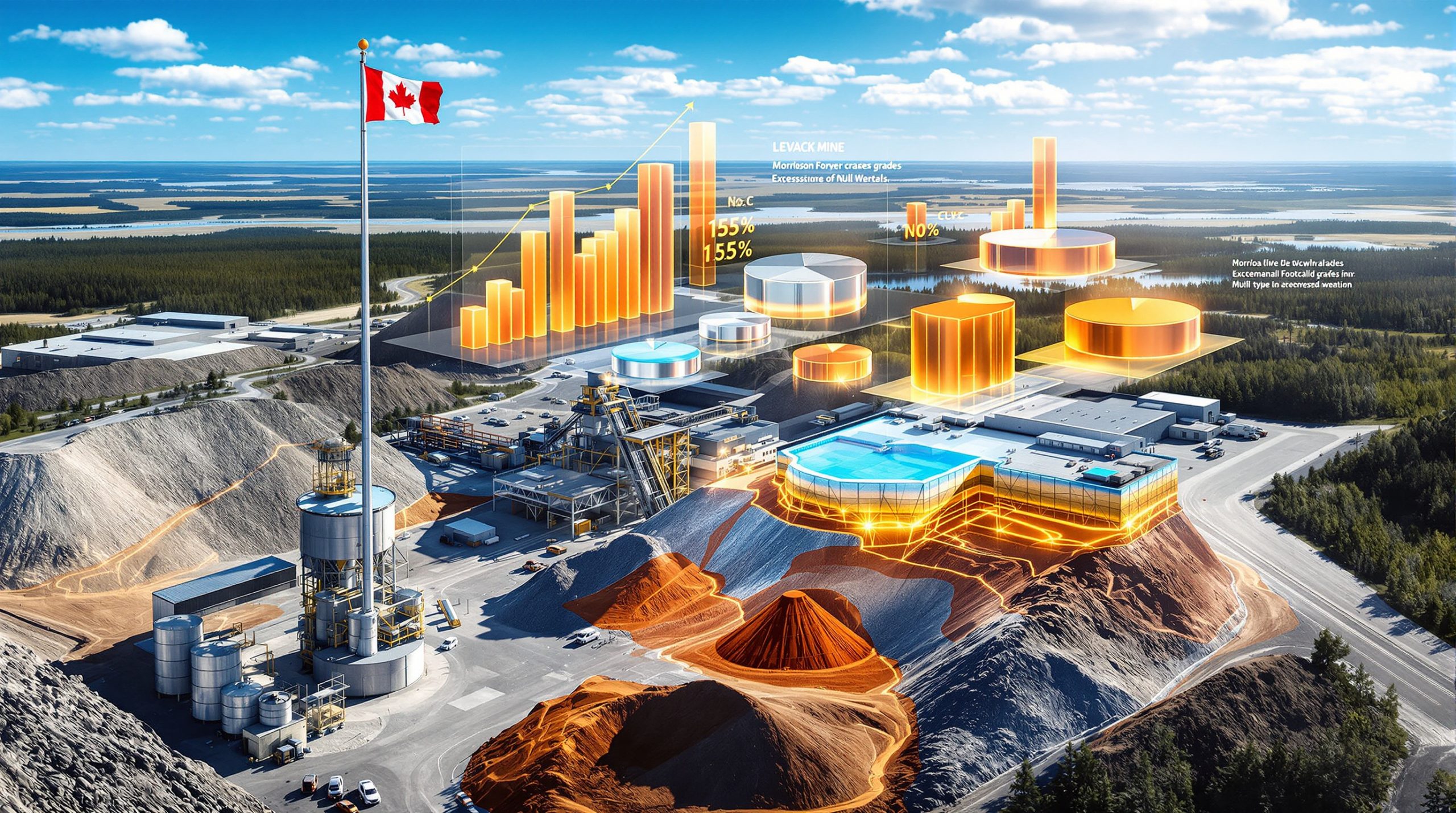Specialized mineralisation environments present unique opportunities for resource extraction when multiple valuable metals concentrate within single ore bodies. The Sudbury Basin in Ontario represents one of the world's most significant polymetallic mining districts, where geological processes have created distinct zones containing copper, nickel, and platinum group elements in commercially viable concentrations. Understanding how these multi-metal systems function provides crucial insights into mineral exploration insights and processing strategies.
Complex ore bodies require sophisticated evaluation methodologies that account for varying metal distributions and recovery characteristics. When high-grade copper and precious metals Levack Mine occur together, traditional single-commodity mining approaches become inadequate. The technical challenges of extracting maximum value from polymetallic deposits demand integrated processing solutions and strategic resource management.
Modern mining operations increasingly focus on multi-metal opportunities as commodity markets evolve and infrastructure costs escalate. The ability to generate revenue streams from multiple metals within a single operation provides operational flexibility and risk mitigation that pure-play commodity projects cannot match. This operational diversification becomes particularly valuable during periods of commodity price volatility.
Geological Framework and Mineralisation Characteristics
The Sudbury Basin's geological structure creates two distinct mineralisation styles that concentrate valuable metals through different formation processes. Contact-type deposits develop where intrusive rocks interact with existing formations, typically hosting nickel-copper assemblages in predictable grade distributions. These deposits form the foundation of many large-scale mining operations due to their consistent metallurgy and substantial tonnages.
Footwall-type deposits represent a different geological environment where hydrothermal processes concentrate copper and platinum group elements in higher-grade zones. These deposits often exhibit superior metal grades but occur in smaller, more irregular ore bodies that require selective mining approaches. The geological controls governing footwall mineralisation create opportunities for discovering additional high-grade zones through systematic exploration.
Levack Mine Resource Distribution Analysis:
| Deposit Type | Tonnage (Mt) | Cu (%) | Ni (%) | Pt (g/t) | Pd (g/t) | CuEq (%) |
|---|---|---|---|---|---|---|
| Contact (Indicated) | 5.9 | 0.9 | 1.4 | 0.6 | 0.7 | 3.2 |
| Footwall (Indicated) | 0.178 | 9.1 | 2.4 | 3.6 | 6.6 | 15.5 |
| Contact (Inferred) | 4.8 | 0.9 | 1.5 | 0.6 | 0.8 | 3.2 |
The resource estimate incorporates data from 10,525 drill holes totalling 1.34 million metres of drilling completed between 1911 and 2025. This extensive database provides exceptional confidence in resource classification and metallurgical characteristics. Furthermore, drilling programs overview density achieved at Levack exceeds industry standards for resource definition, supporting advanced mine planning and processing optimisation studies.
Mineralisation remains open at depth in multiple zones, suggesting significant expansion potential below current resource boundaries. Systematic exploration of deeper targets could substantially increase the total resource base while maintaining or improving average grades. The geological continuity observed in existing drilling supports the likelihood of discovering additional ore zones through focused exploration programmes.
High-Grade Footwall Deposits: Exceptional Value Concentration
Morrison Footwall deposits demonstrate remarkable grade characteristics that fundamentally alter project economics compared to typical copper mining operations. With 15.5% copper equivalent grades in indicated resources, these ore bodies generate revenue densities that justify selective mining and premium processing approaches. The combination of high copper grades with significant precious metals content creates multiple revenue streams within single ore tonnes.
Morrison Footwall Detailed Grade Distribution:
• Copper: 9.1% (primary revenue driver)
• Platinum: 3.6 g/t (premium metals revenue)
• Palladium: 6.6 g/t (automotive catalyst demand)
• Gold: 1.6 g/t (additional precious metals value)
• Silver: 34.2 g/t (industrial applications revenue)
The No. 3 Footwall deposit contains 76,000 tonnes of inferred material with even higher precious metals concentrations. Palladium grades of 15.7 g/t represent exceptional enrichment levels that typically occur only in primary platinum group element operations. Combined platinum and palladium grades exceeding 23 g/t create substantial additional revenue potential beyond copper production.
Revenue diversification through precious metals recovery provides significant operational advantages during commodity price cycles. When copper prices decline, platinum and palladium revenues can maintain cash flow generation and operational continuity. This multi-metal approach reduces project risk profiles and enhances financing attractiveness for development capital.
Infrastructure advantages at existing shaft locations eliminate typical development timelines associated with accessing high-grade ore zones. The No. 2 Shaft provides immediate access to Morrison Footwall deposits without requiring new shaft development, reducing capital expenditure and accelerating production timelines by 2-3 years compared to greenfield projects.
Depth extension potential remains largely untested below current resource boundaries. Underground drilling planned for 2026 will evaluate deeper mineralisation zones that could substantially expand the high-grade resource base. Geological continuity suggests that additional footwall-type deposits may exist at accessible depths within the established mining infrastructure envelope.
Processing Strategies for Multi-Metal Value Optimisation
Multi-metal ore bodies require sophisticated processing approaches that maximise recovery across all valuable commodities while maintaining operational efficiency. Selective mining strategies enable segregation of high-grade footwall material from lower-grade contact deposits, allowing optimisation of processing circuits for specific ore characteristics. This approach maximises concentrate quality while reducing processing costs per unit of metal produced.
Strategic Processing Considerations:
• Gravity Concentration: Initial recovery of free metals and high-density minerals
• Flotation Circuits: Selective separation of copper, nickel, and precious metals
• Concentrate Upgrading: Enhancement of metal content for premium smelter terms
• Precious Metals Recovery: Dedicated circuits for platinum, palladium, and gold extraction
High-grade ore bodies enable premium concentrate production that commands favourable smelter treatment terms and reduced transportation costs. When copper concentrates exceed 30% metal content, smelters typically offer improved treatment charges and penalty structures that directly enhance net smelter returns. The combination of high grades and multiple metal credits creates concentrate products that access premium pricing mechanisms.
Processing facility design must accommodate varying ore characteristics between footwall and contact-type deposits. Footwall material requires circuits optimised for precious metals recovery, while contact deposits benefit from conventional nickel-copper separation techniques. However, advanced 3D modelling allows optimisation of mill feed blending to maintain consistent metallurgical performance across different ore types.
"Multi-metal processing circuits generate significantly higher net present values when designed for maximum metal recovery across all commodities, but require substantial technical expertise and capital investment to achieve optimal performance."
Contact-Type Deposits: Large-Scale Production Foundation
Contact-type mineralisation provides the tonnage base necessary for sustained mining operations while high-grade footwall deposits serve as value accelerators. The 5.9 million tonnes of indicated contact resources offer consistent metallurgy and predictable processing characteristics that support long-term production planning and infrastructure investment decisions.
Contact Deposit Characteristics Analysis:
| Parameter | Indicated | Inferred | Combined Total |
|---|---|---|---|
| Tonnage | 5.9 Mt | 4.8 Mt | 10.7 Mt |
| Copper Grade | 0.9% | 0.9% | 0.9% |
| Nickel Grade | 1.4% | 1.5% | 1.45% |
| Processing Life | ~12-15 years | Additional 8-10 years | 20+ years |
Production scheduling optimisation allows flexible extraction sequencing that responds to commodity market conditions while maintaining operational continuity. During copper price peaks, higher-grade footwall material can be prioritised to maximise cash flow generation. When commodity prices decline, consistent contact-type deposits provide steady production volumes that support infrastructure utilisation and workforce retention.
Infrastructure requirements for contact-type deposits justify major capital investments including shaft recommissioning, processing plant development, and underground access systems. The substantial resource tonnage supports extended mine life scenarios that provide adequate payback periods for significant infrastructure expenditure. Once established, this infrastructure creates operational synergies that enhance overall project economics.
Underground access development between shaft stations enables efficient extraction of both deposit types using shared infrastructure systems. The planned connection between No. 2 and No. 3 shaft stations, scheduled for completion in Q2 2026, will facilitate coordinated mining of different ore zones while optimising transportation and ventilation systems.
Economic Drivers and Development Strategy
Capital investment requirements for restarting Levack operations focus on infrastructure recommissioning rather than new facility construction. Existing shaft systems, underground workings, and regional processing infrastructure provide substantial capital advantages compared to greenfield development scenarios. These infrastructure benefits enable accelerated development timelines and reduced total project investment.
Development Timeline Projections:
• Q1 2026: No. 2 Shaft hoisting system recommissioning commencement
• Q2 2026: Underground connection between shaft stations completion
• 2026: Preliminary Economic Assessment completion and production restart evaluation
• 2026-2027: Underground drilling programmes for resource expansion
Market positioning in critical minerals supply chains provides access to premium pricing mechanisms and long-term supply agreements that enhance project valuation beyond spot commodity pricing. Copper demand for renewable energy infrastructure and platinum group elements for automotive catalysts create strategic market opportunities that support sustainable operations.
Operational risk mitigation through multi-commodity production inherently reduces exposure to single-metal price volatility. Revenue diversification across copper, nickel, platinum, palladium, gold, and silver creates more predictable cash flows that support debt service and operational continuity during varying market conditions. Furthermore, this approach aligns with broader mining industry evolution towards multi-metal operations.
Revenue Stream Analysis (Morrison Footwall):
• Base Metals (Cu+Ni): Primary cash flow generation (~60-70% of total revenue)
• Platinum Group Elements: Premium revenue stream (~25-30% of total revenue)
• Gold and Silver: Additional revenue contribution (~5-10% of total revenue)
What Makes Levack's Nickel Resources Particularly Valuable?
The high-grade copper and precious metals Levack Mine also contains significant nickel resources that complement its multi-metal profile. The nickel significance overview demonstrates how nickel demand for electric vehicle batteries and stainless steel production continues expanding globally. In addition, Levack's nickel grades averaging 1.4-1.5% in contact deposits provide substantial additional revenue streams that enhance overall project economics.
Infrastructure Advantages and Operational Readiness
The No. 2 Shaft system provides immediate access to mineralised zones without the extensive development timelines typically required for new mining projects. Current capabilities include personnel and material transportation, with expansion potential for ore hoisting through relatively modest capital investment. This infrastructure advantage eliminates 3-5 years of shaft development time compared to greenfield operations.
Underground development programmes create exploration platforms that enable resource expansion drilling while maintaining operational flexibility. Concurrent resource development and production preparation optimise capital deployment and reduce overall project risk profiles. The ability to conduct exploration and development simultaneously accelerates time-to-production timelines.
Regional processing infrastructure in the Sudbury Basin provides multiple options for toll milling arrangements or facility acquisition that could further accelerate production commencement. Established metallurgical expertise and equipment availability reduce development risks and capital requirements while providing access to proven processing technologies.
Workforce and Operational Advantages:
• Skilled Labour Availability: Sudbury Basin's experienced mining workforce
• Reduced Training Costs: Personnel familiar with similar operations
• Operational Knowledge: Understanding of local geological and processing conditions
• Rapid Production Ramp-up: Minimised learning curve and operational delays
Exploration Potential and Resource Expansion
Current drilling programmes focus on expanding known deposits laterally and at depth, with particular emphasis on Morrison Footwall extensions below existing resource boundaries. The open nature of mineralisation at depth suggests substantial resource growth potential that could support larger-scale operations with enhanced economies of scale.
Systematic exploration of regional geological targets could identify additional footwall-type deposits with comparable high-grade characteristics. The Levack property covers extensive prospective geology within the Sudbury Basin, suggesting significant exploration upside beyond current resource areas. Regional target generation based on geological and geophysical analysis continues to identify new drilling priorities.
Technology Applications for Deep Exploration:
• 3D Seismic Surveys: Identification of structural controls and mineralisation targets
• Deep Electromagnetic Surveys: Detection of conductive mineralisation at depth
• Advanced Geophysical Techniques: Integration of multiple survey methods for target refinement
• Systematic Drilling Programmes: Step-out drilling to test geological continuity
Modern exploration techniques enable identification of mineralisation targets at depths beyond current drilling coverage. The exceptional grades encountered in shallow drilling suggest that deeper exploration could reveal larger, higher-grade ore bodies that transform project scale and economics. Systematic application of advanced exploration technologies maximises discovery potential while optimising exploration expenditure.
Resource expansion potential extends beyond immediate mine planning requirements to long-term strategic development scenarios. Additional high-grade zones could justify expanded processing capacity and enhanced infrastructure development that creates regional mining hub opportunities. The combination of existing infrastructure and exploration potential positions Levack for substantial resource growth.
Market Fundamentals and Strategic Positioning
Global copper demand continues expanding driven by renewable energy infrastructure development, electric vehicle adoption, and grid modernisation requirements worldwide. Supply constraints from major producing regions create favourable long-term pricing environments that support high-grade copper project development with attractive investment returns. Critical minerals policy initiatives further enhance development prospects for domestic copper production.
Platinum and palladium market dynamics remain influenced by automotive catalyst requirements despite electric vehicle transition trends. Industrial demand for platinum in hydrogen economy applications and palladium in semiconductor manufacturing creates additional demand drivers beyond traditional automotive usage. The combination of supply constraints and diversifying demand creates premium pricing opportunities for high-grade production.
Critical Minerals Policy Support:
• Tax Incentives: Favourable treatment for domestic critical minerals production
• Infrastructure Investment: Government support for mining region development
• Streamlined Permitting: Reduced regulatory timelines for strategic projects
• Supply Chain Security: Priority designation for critical minerals operations
Investment fundamentals for multi-metal projects benefit from portfolio diversification effects that reduce overall risk profiles compared to single-commodity operations. Financial markets increasingly recognise the value creation potential of operations that generate revenue streams across multiple metals, particularly when those metals address different end-use markets and demand cycles. Additionally, Magna Mining's high-grade copper resource positions the project favourably within the critical minerals supply chain.
Production Restart Strategy and Value Creation
Phased development approaches beginning with high-grade footwall deposits enable rapid cash flow generation while funding subsequent development phases for larger-scale operations. This strategy minimises initial capital requirements while demonstrating operational capabilities that support additional financing for expanded development programmes.
Initial production focus on high-grade copper and precious metals Levack Mine concentrates maximises revenue per tonne processed while requiring minimal processing infrastructure investment. Premium concentrate quality commands favourable smelter terms and reduced treatment charges that enhance net smelter returns. As operations expand, additional processing circuits can be integrated to optimise recovery across all metal commodities.
Phased Development Sequence:
-
Phase 1: Morrison Footwall high-grade production startup
-
Phase 2: Contact deposit integration for sustained production
-
Phase 3: Additional footwall zones development and processing expansion
-
Phase 4: Resource expansion through exploration success integration
Production restart strategies leverage existing infrastructure while incorporating modern mining and processing technologies that enhance operational efficiency and environmental performance. The combination of established infrastructure and contemporary technical approaches creates competitive operational advantages that support sustainable long-term mining operations.
Strategic positioning within critical minerals supply chains provides access to long-term supply agreements and premium pricing mechanisms that enhance project stability and financial returns. The multi-metal production profile aligns with evolving demand patterns across renewable energy, automotive, and industrial applications that support sustained market positioning.
Want to Stay Ahead of the Next Major Mineral Discovery?
Discovery Alert's proprietary Discovery IQ model delivers real-time notifications on significant ASX mineral discoveries, instantly empowering subscribers to identify actionable opportunities like high-grade copper and precious metals projects before the broader market reacts. Discover why historic mineral discoveries have generated exceptional returns and begin your 30-day free trial today to position yourself ahead of the competition.




